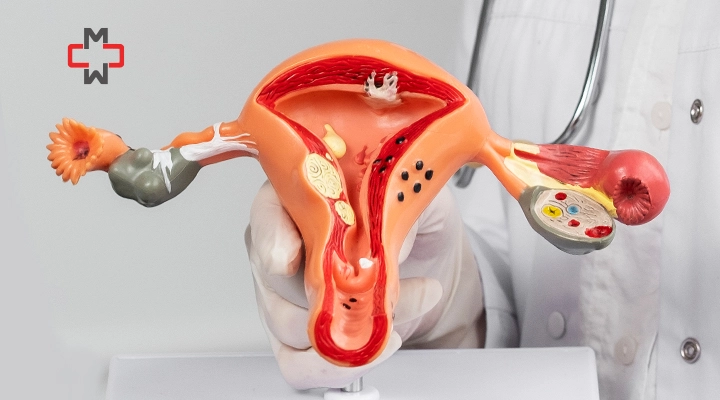What Are Ovarian Cysts?
Ovarian cysts are fluid-filled sacs that develop on the ovaries. They are relatively common and can occur during a woman’s menstrual cycle. Most ovarian cysts are benign (non-cancerous) and do not cause significant health issues. However, some cysts can lead to complications if they grow large or rupture.
Types of Ovarian Cysts
- Functional Cysts: These are the most common type and include:
- Follicular Cysts: Form when the follicle (which contains the egg) does not release the egg.
- Corpus Luteum Cysts: Develop after the follicle releases the egg and the follicle reseals and fills with fluid.
- Pathological Cysts: These are less common and can be benign or malignant. They include:
- Dermoid Cysts: Contain tissue such as hair, skin, or teeth.
- Endometriomas: Associated with endometriosis, these cysts form from endometrial tissue.
- Cystadenomas: Develop from ovarian tissue and can be filled with a watery or mucous substance.
Size of Ovarian Cysts
Ovarian cysts can vary significantly in size. Here’s a general classification:
| Size Category | Size (in cm) | Description |
|---|---|---|
| Small Cysts | 1-3 cm | Typically harmless and often resolve on their own. |
| Medium Cysts | 4-6 cm | May require monitoring; often asymptomatic. |
| Large Cysts | 7-10 cm | Increased risk of complications; may require intervention. |
| Very Large Cysts | >10 cm | High risk of rupture or torsion; often necessitates surgical evaluation. |
When Are Ovarian Cysts Dangerous?
While most ovarian cysts are harmless, certain sizes and types can pose risks:
- Size: Cysts larger than 5 cm are more likely to cause complications. Very large cysts (over 10 cm) can lead to:
- Rupture: This can cause severe pain and internal bleeding.
- Ovarian torsion: The cyst can cause the ovary to twist, cutting off its blood supply, which is a medical emergency.
- Type: Certain types of cysts, particularly those that are pathological, may have a higher risk of being cancerous, especially in postmenopausal women.
- Symptoms: Symptoms such as severe pelvic pain, bloating, or changes in menstrual cycles may indicate complications and warrant immediate medical attention.
Diagnosis of Ovarian Cysts
Ovarian cysts are typically diagnosed through:
- Pelvic Ultrasound: This imaging test provides a clear view of the ovaries and any cysts present.
- CT or MRI Scans: These may be used for further evaluation if necessary.
- Blood Tests: To check for tumor markers, especially if there is concern about cancer.
Treatment Options
Treatment for ovarian cysts depends on their size, type, and symptoms:
- Watchful Waiting: Many small functional cysts resolve without treatment.
- Medications: Hormonal contraceptives may be prescribed to prevent the formation of new cysts.
- Surgery: Cysts that are large, persistent, or symptomatic may require surgical intervention, either through laparoscopy or laparotomy.
Prevention and Management
While not all cysts can be prevented, certain measures can help manage ovarian health:
- Regular Check-ups: Routine pelvic exams can help monitor ovarian health.
- Healthy Lifestyle: A balanced diet and regular exercise may support overall reproductive health.
- Awareness of Symptoms: Being vigilant about changes in menstrual cycles or pelvic pain can lead to early detection of potential issues.
FAQ Section
Q1: What size of ovarian cyst is considered large?
A cyst larger than 5 cm is generally considered large and may require monitoring or treatment.
Q2: Are all ovarian cysts dangerous?
No, most ovarian cysts are benign and resolve on their own. However, larger cysts or certain types can pose risks.
Q3: What symptoms indicate a potentially dangerous cyst?
Severe pelvic pain, bloating, and changes in menstrual cycles may indicate complications and should prompt medical evaluation.
Q4: How are ovarian cysts treated?
Treatment options include watchful waiting, hormonal medications, or surgery, depending on the size and symptoms of the cyst.
Q5: Can ovarian cysts affect fertility?
Most functional cysts do not affect fertility, but underlying conditions like endometriosis can impact reproductive health.
Q6: How often should women have pelvic exams?
Women should have regular pelvic exams, typically annually, or as recommended by their healthcare provider.
Q7: Can lifestyle changes help prevent ovarian cysts?
While not all cysts can be prevented, maintaining a healthy lifestyle may support overall reproductive health.
Q8: What is the risk of cancer with ovarian cysts?
The risk of cancer increases with age and certain types of cysts, particularly in postmenopausal women. Regular monitoring is essential.
Q9: What happens if an ovarian cyst ruptures?
A ruptured cyst can cause severe pain and internal bleeding, requiring immediate medical attention.
Q10: Are there any home remedies for ovarian cysts?
While some lifestyle changes may help manage symptoms, it is essential to consult a healthcare provider for proper diagnosis and treatment.
Additional Information
For more detailed information on ovarian cysts, you can refer to the following resource: Ovarian Cysts – Wikipedia.






More Stories
Where to Watch USMNT vs Jamaica National Football Team
How I Met My Monster
How Should a Ring Fit